Business Strategy Report: Strategic Analysis of the Tobacco Industry
VerifiedAdded on 2022/09/21
|20
|3596
|20
Report
AI Summary
This report provides a strategic market analysis of the tobacco industry, examining its business strategy through Porter's five forces and McKinsey 7S framework. It analyzes the threat of new entrants, bargaining power of buyers and suppliers, threat of substitutes, and industry rivalry, along with internal capabilities. The report identifies opportunities and threats, followed by an evaluation of the tobacco industry's marketing strategies, including product life cycle, segmentation, targeting, and positioning, product market strategies, and the BCG matrix. It also discusses the industry's maturity stage, customer segmentation, and future opportunities, such as diversification. The report concludes with a summary of the strategic management process and the challenges and strategies employed by tobacco companies to maintain and increase profitability in a competitive environment.
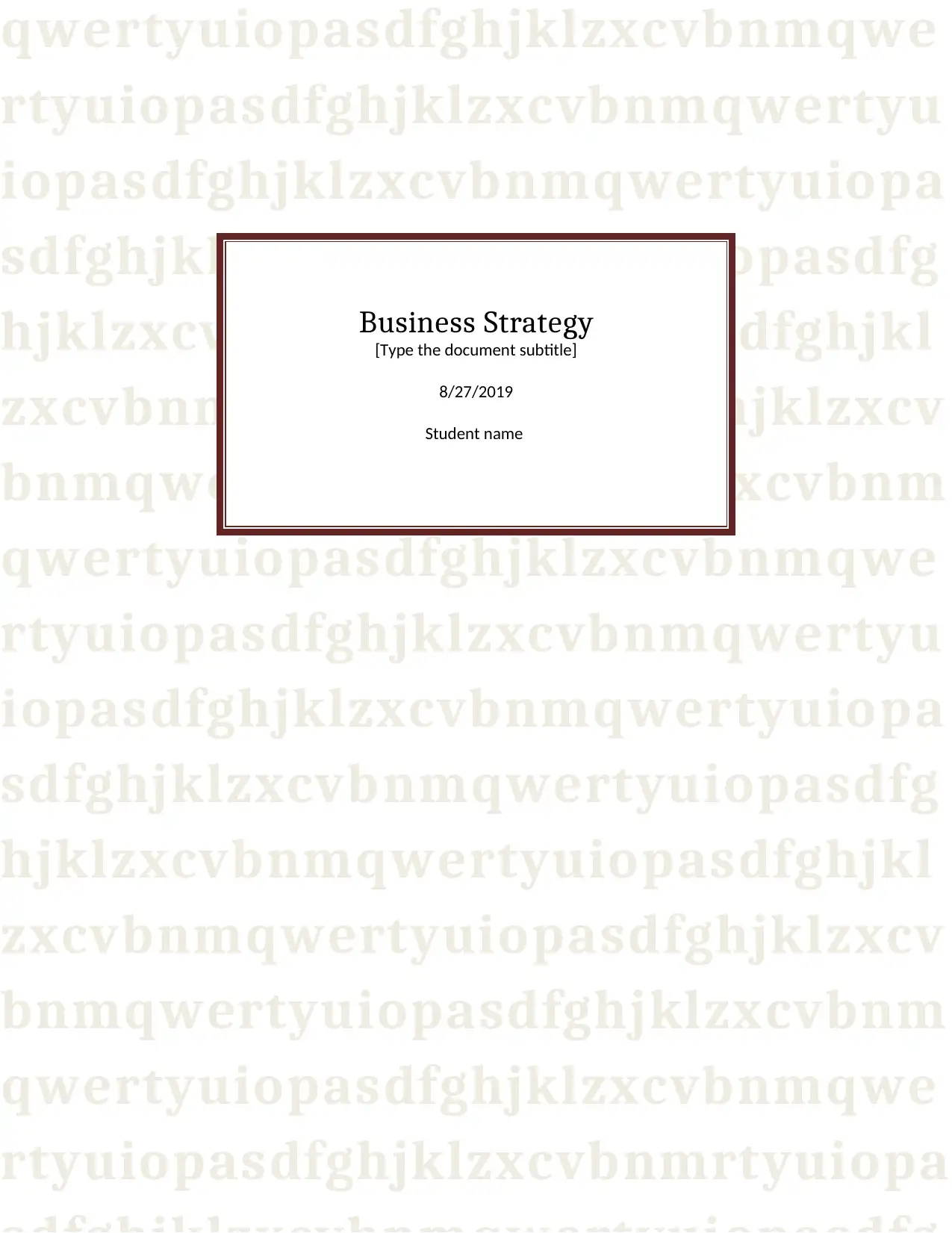
qwertyuiopasdfghjklzxcvbnmqwe
rtyuiopasdfghjklzxcvbnmqwertyu
iopasdfghjklzxcvbnmqwertyuiopa
sdfghjklzxcvbnmqwertyuiopasdfg
hjklzxcvbnmqwertyuiopasdfghjkl
zxcvbnmqwertyuiopasdfghjklzxcv
bnmqwertyuiopasdfghjklzxcvbnm
qwertyuiopasdfghjklzxcvbnmqwe
rtyuiopasdfghjklzxcvbnmqwertyu
iopasdfghjklzxcvbnmqwertyuiopa
sdfghjklzxcvbnmqwertyuiopasdfg
hjklzxcvbnmqwertyuiopasdfghjkl
zxcvbnmqwertyuiopasdfghjklzxcv
bnmqwertyuiopasdfghjklzxcvbnm
qwertyuiopasdfghjklzxcvbnmqwe
rtyuiopasdfghjklzxcvbnmrtyuiopa
Business Strategy
[Type the document subtitle]
8/27/2019
Student name
rtyuiopasdfghjklzxcvbnmqwertyu
iopasdfghjklzxcvbnmqwertyuiopa
sdfghjklzxcvbnmqwertyuiopasdfg
hjklzxcvbnmqwertyuiopasdfghjkl
zxcvbnmqwertyuiopasdfghjklzxcv
bnmqwertyuiopasdfghjklzxcvbnm
qwertyuiopasdfghjklzxcvbnmqwe
rtyuiopasdfghjklzxcvbnmqwertyu
iopasdfghjklzxcvbnmqwertyuiopa
sdfghjklzxcvbnmqwertyuiopasdfg
hjklzxcvbnmqwertyuiopasdfghjkl
zxcvbnmqwertyuiopasdfghjklzxcv
bnmqwertyuiopasdfghjklzxcvbnm
qwertyuiopasdfghjklzxcvbnmqwe
rtyuiopasdfghjklzxcvbnmrtyuiopa
Business Strategy
[Type the document subtitle]
8/27/2019
Student name
Paraphrase This Document
Need a fresh take? Get an instant paraphrase of this document with our AI Paraphraser
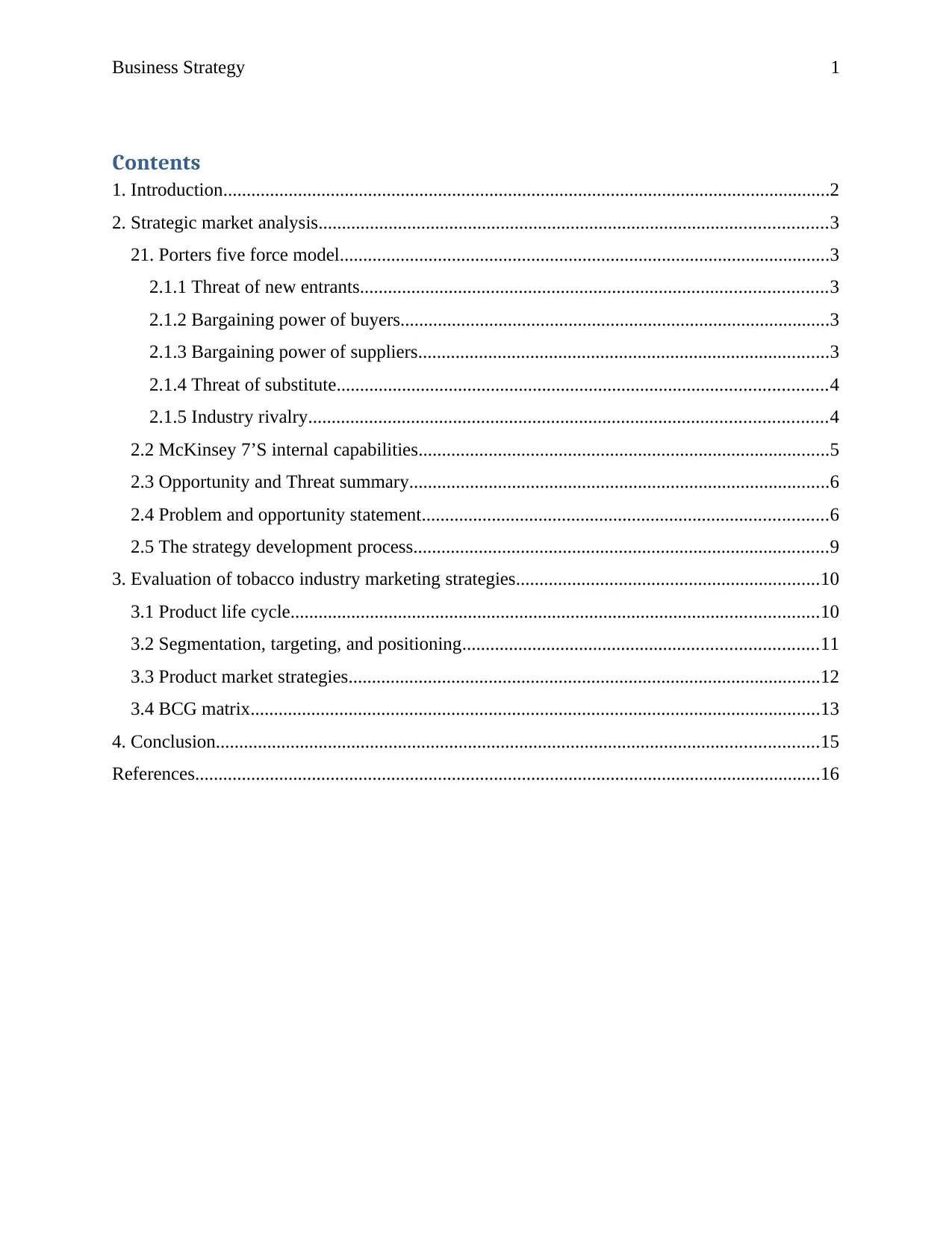
Business Strategy 1
Contents
1. Introduction..................................................................................................................................2
2. Strategic market analysis.............................................................................................................3
21. Porters five force model.........................................................................................................3
2.1.1 Threat of new entrants....................................................................................................3
2.1.2 Bargaining power of buyers............................................................................................3
2.1.3 Bargaining power of suppliers........................................................................................3
2.1.4 Threat of substitute.........................................................................................................4
2.1.5 Industry rivalry...............................................................................................................4
2.2 McKinsey 7’S internal capabilities........................................................................................5
2.3 Opportunity and Threat summary..........................................................................................6
2.4 Problem and opportunity statement.......................................................................................6
2.5 The strategy development process.........................................................................................9
3. Evaluation of tobacco industry marketing strategies.................................................................10
3.1 Product life cycle.................................................................................................................10
3.2 Segmentation, targeting, and positioning............................................................................11
3.3 Product market strategies.....................................................................................................12
3.4 BCG matrix..........................................................................................................................13
4. Conclusion.................................................................................................................................15
References......................................................................................................................................16
Contents
1. Introduction..................................................................................................................................2
2. Strategic market analysis.............................................................................................................3
21. Porters five force model.........................................................................................................3
2.1.1 Threat of new entrants....................................................................................................3
2.1.2 Bargaining power of buyers............................................................................................3
2.1.3 Bargaining power of suppliers........................................................................................3
2.1.4 Threat of substitute.........................................................................................................4
2.1.5 Industry rivalry...............................................................................................................4
2.2 McKinsey 7’S internal capabilities........................................................................................5
2.3 Opportunity and Threat summary..........................................................................................6
2.4 Problem and opportunity statement.......................................................................................6
2.5 The strategy development process.........................................................................................9
3. Evaluation of tobacco industry marketing strategies.................................................................10
3.1 Product life cycle.................................................................................................................10
3.2 Segmentation, targeting, and positioning............................................................................11
3.3 Product market strategies.....................................................................................................12
3.4 BCG matrix..........................................................................................................................13
4. Conclusion.................................................................................................................................15
References......................................................................................................................................16
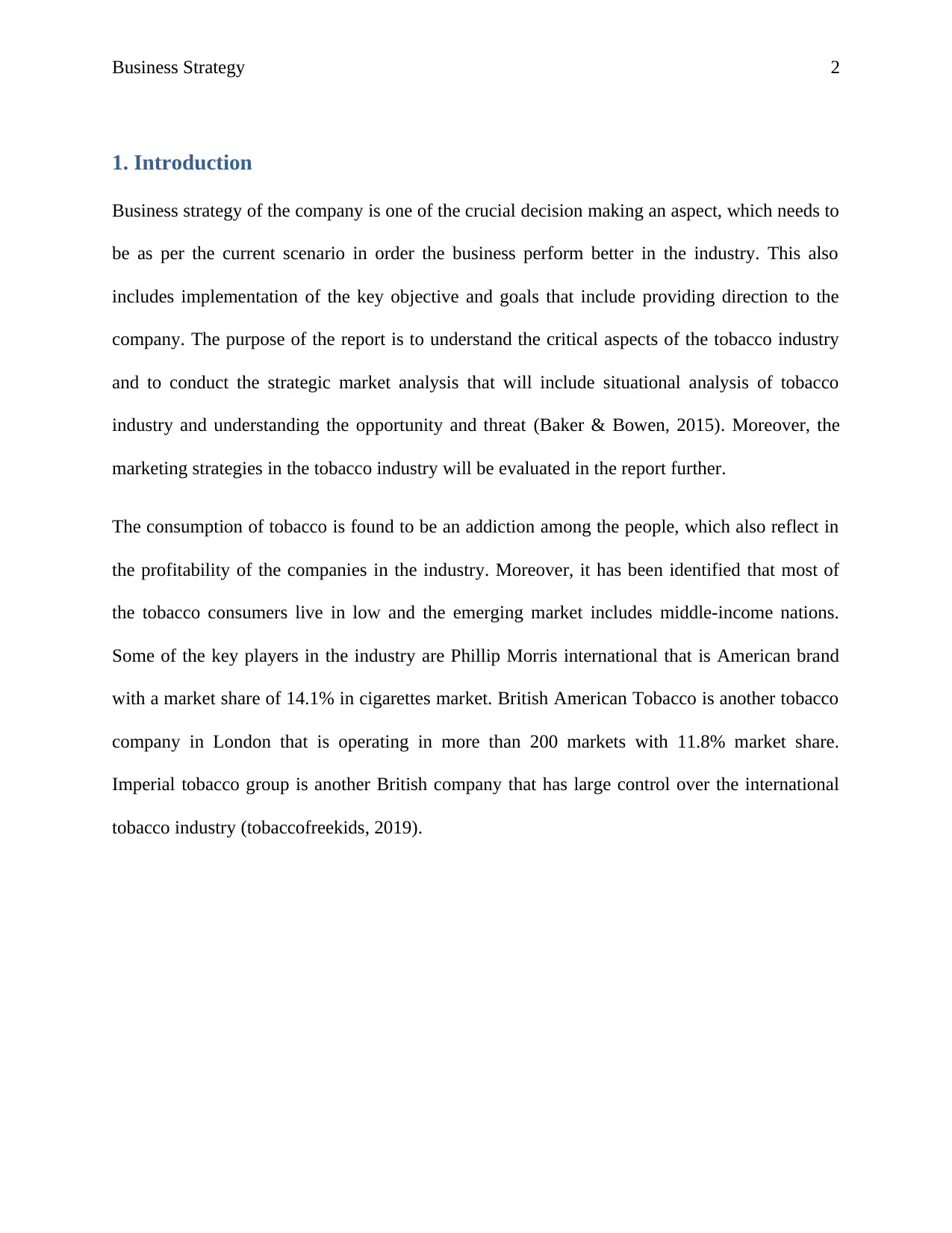
Business Strategy 2
1. Introduction
Business strategy of the company is one of the crucial decision making an aspect, which needs to
be as per the current scenario in order the business perform better in the industry. This also
includes implementation of the key objective and goals that include providing direction to the
company. The purpose of the report is to understand the critical aspects of the tobacco industry
and to conduct the strategic market analysis that will include situational analysis of tobacco
industry and understanding the opportunity and threat (Baker & Bowen, 2015). Moreover, the
marketing strategies in the tobacco industry will be evaluated in the report further.
The consumption of tobacco is found to be an addiction among the people, which also reflect in
the profitability of the companies in the industry. Moreover, it has been identified that most of
the tobacco consumers live in low and the emerging market includes middle-income nations.
Some of the key players in the industry are Phillip Morris international that is American brand
with a market share of 14.1% in cigarettes market. British American Tobacco is another tobacco
company in London that is operating in more than 200 markets with 11.8% market share.
Imperial tobacco group is another British company that has large control over the international
tobacco industry (tobaccofreekids, 2019).
1. Introduction
Business strategy of the company is one of the crucial decision making an aspect, which needs to
be as per the current scenario in order the business perform better in the industry. This also
includes implementation of the key objective and goals that include providing direction to the
company. The purpose of the report is to understand the critical aspects of the tobacco industry
and to conduct the strategic market analysis that will include situational analysis of tobacco
industry and understanding the opportunity and threat (Baker & Bowen, 2015). Moreover, the
marketing strategies in the tobacco industry will be evaluated in the report further.
The consumption of tobacco is found to be an addiction among the people, which also reflect in
the profitability of the companies in the industry. Moreover, it has been identified that most of
the tobacco consumers live in low and the emerging market includes middle-income nations.
Some of the key players in the industry are Phillip Morris international that is American brand
with a market share of 14.1% in cigarettes market. British American Tobacco is another tobacco
company in London that is operating in more than 200 markets with 11.8% market share.
Imperial tobacco group is another British company that has large control over the international
tobacco industry (tobaccofreekids, 2019).
⊘ This is a preview!⊘
Do you want full access?
Subscribe today to unlock all pages.

Trusted by 1+ million students worldwide
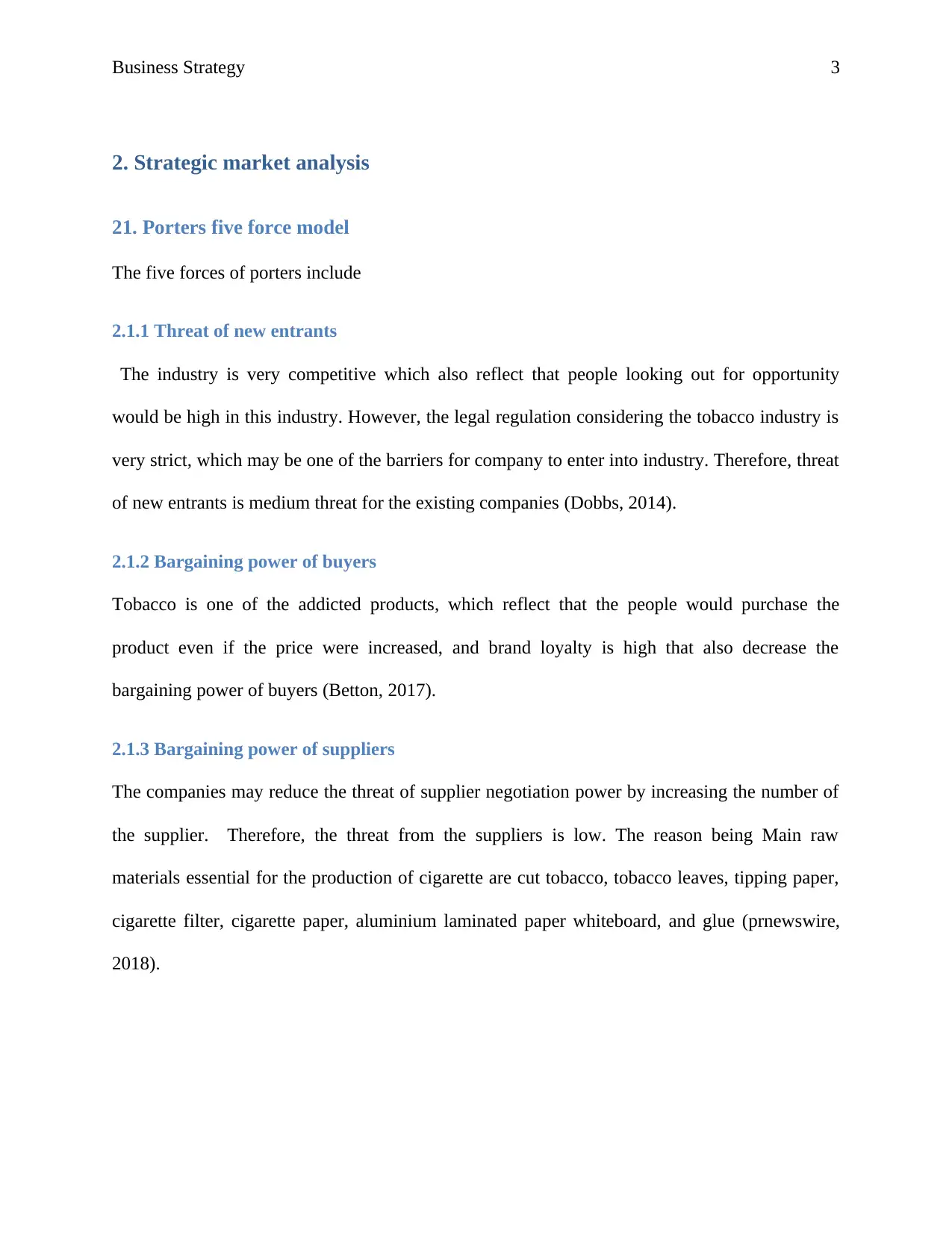
Business Strategy 3
2. Strategic market analysis
21. Porters five force model
The five forces of porters include
2.1.1 Threat of new entrants
The industry is very competitive which also reflect that people looking out for opportunity
would be high in this industry. However, the legal regulation considering the tobacco industry is
very strict, which may be one of the barriers for company to enter into industry. Therefore, threat
of new entrants is medium threat for the existing companies (Dobbs, 2014).
2.1.2 Bargaining power of buyers
Tobacco is one of the addicted products, which reflect that the people would purchase the
product even if the price were increased, and brand loyalty is high that also decrease the
bargaining power of buyers (Betton, 2017).
2.1.3 Bargaining power of suppliers
The companies may reduce the threat of supplier negotiation power by increasing the number of
the supplier. Therefore, the threat from the suppliers is low. The reason being Main raw
materials essential for the production of cigarette are cut tobacco, tobacco leaves, tipping paper,
cigarette filter, cigarette paper, aluminium laminated paper whiteboard, and glue (prnewswire,
2018).
2. Strategic market analysis
21. Porters five force model
The five forces of porters include
2.1.1 Threat of new entrants
The industry is very competitive which also reflect that people looking out for opportunity
would be high in this industry. However, the legal regulation considering the tobacco industry is
very strict, which may be one of the barriers for company to enter into industry. Therefore, threat
of new entrants is medium threat for the existing companies (Dobbs, 2014).
2.1.2 Bargaining power of buyers
Tobacco is one of the addicted products, which reflect that the people would purchase the
product even if the price were increased, and brand loyalty is high that also decrease the
bargaining power of buyers (Betton, 2017).
2.1.3 Bargaining power of suppliers
The companies may reduce the threat of supplier negotiation power by increasing the number of
the supplier. Therefore, the threat from the suppliers is low. The reason being Main raw
materials essential for the production of cigarette are cut tobacco, tobacco leaves, tipping paper,
cigarette filter, cigarette paper, aluminium laminated paper whiteboard, and glue (prnewswire,
2018).
Paraphrase This Document
Need a fresh take? Get an instant paraphrase of this document with our AI Paraphraser
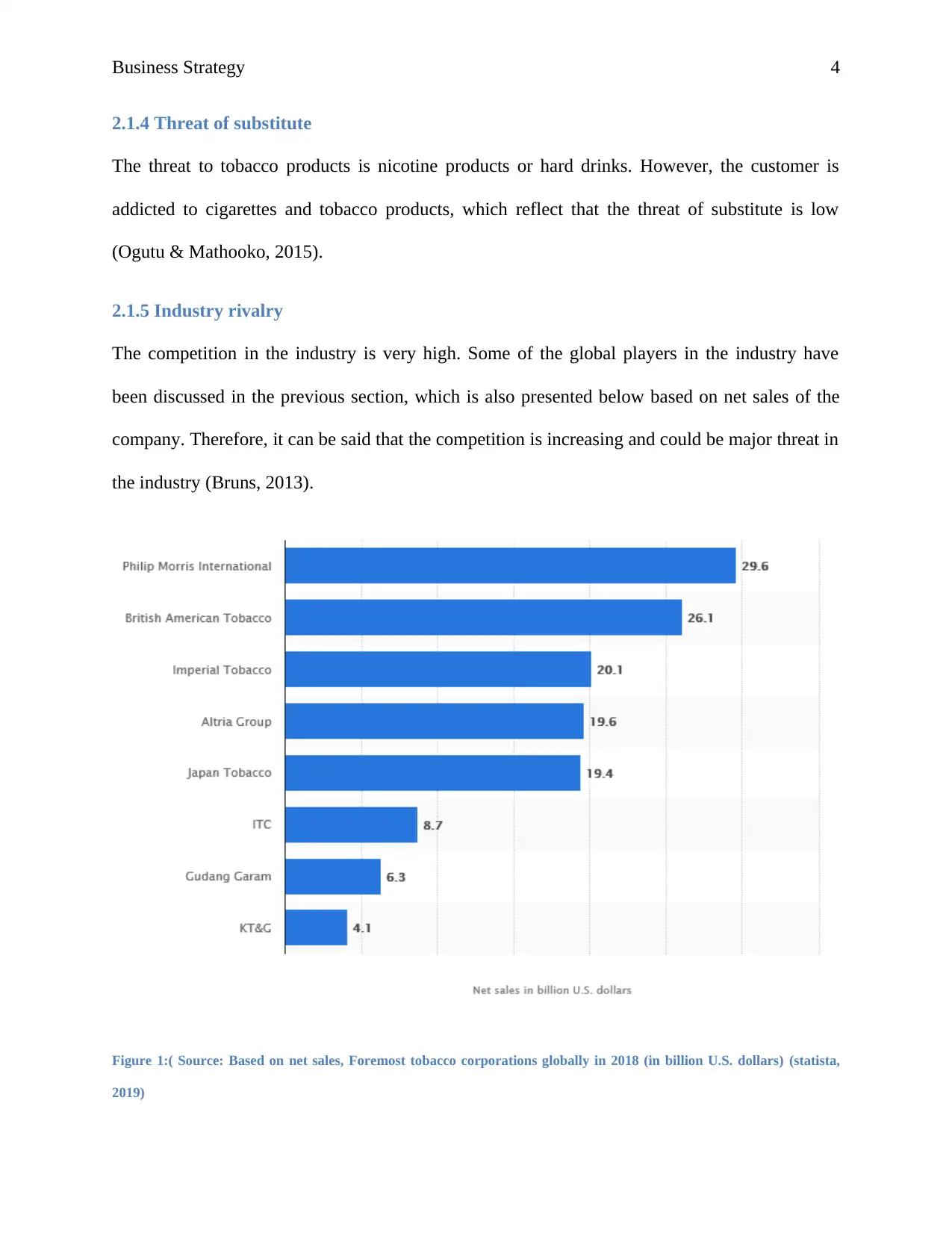
Business Strategy 4
2.1.4 Threat of substitute
The threat to tobacco products is nicotine products or hard drinks. However, the customer is
addicted to cigarettes and tobacco products, which reflect that the threat of substitute is low
(Ogutu & Mathooko, 2015).
2.1.5 Industry rivalry
The competition in the industry is very high. Some of the global players in the industry have
been discussed in the previous section, which is also presented below based on net sales of the
company. Therefore, it can be said that the competition is increasing and could be major threat in
the industry (Bruns, 2013).
Figure 1:( Source: Based on net sales, Foremost tobacco corporations globally in 2018 (in billion U.S. dollars) (statista,
2019)
2.1.4 Threat of substitute
The threat to tobacco products is nicotine products or hard drinks. However, the customer is
addicted to cigarettes and tobacco products, which reflect that the threat of substitute is low
(Ogutu & Mathooko, 2015).
2.1.5 Industry rivalry
The competition in the industry is very high. Some of the global players in the industry have
been discussed in the previous section, which is also presented below based on net sales of the
company. Therefore, it can be said that the competition is increasing and could be major threat in
the industry (Bruns, 2013).
Figure 1:( Source: Based on net sales, Foremost tobacco corporations globally in 2018 (in billion U.S. dollars) (statista,
2019)
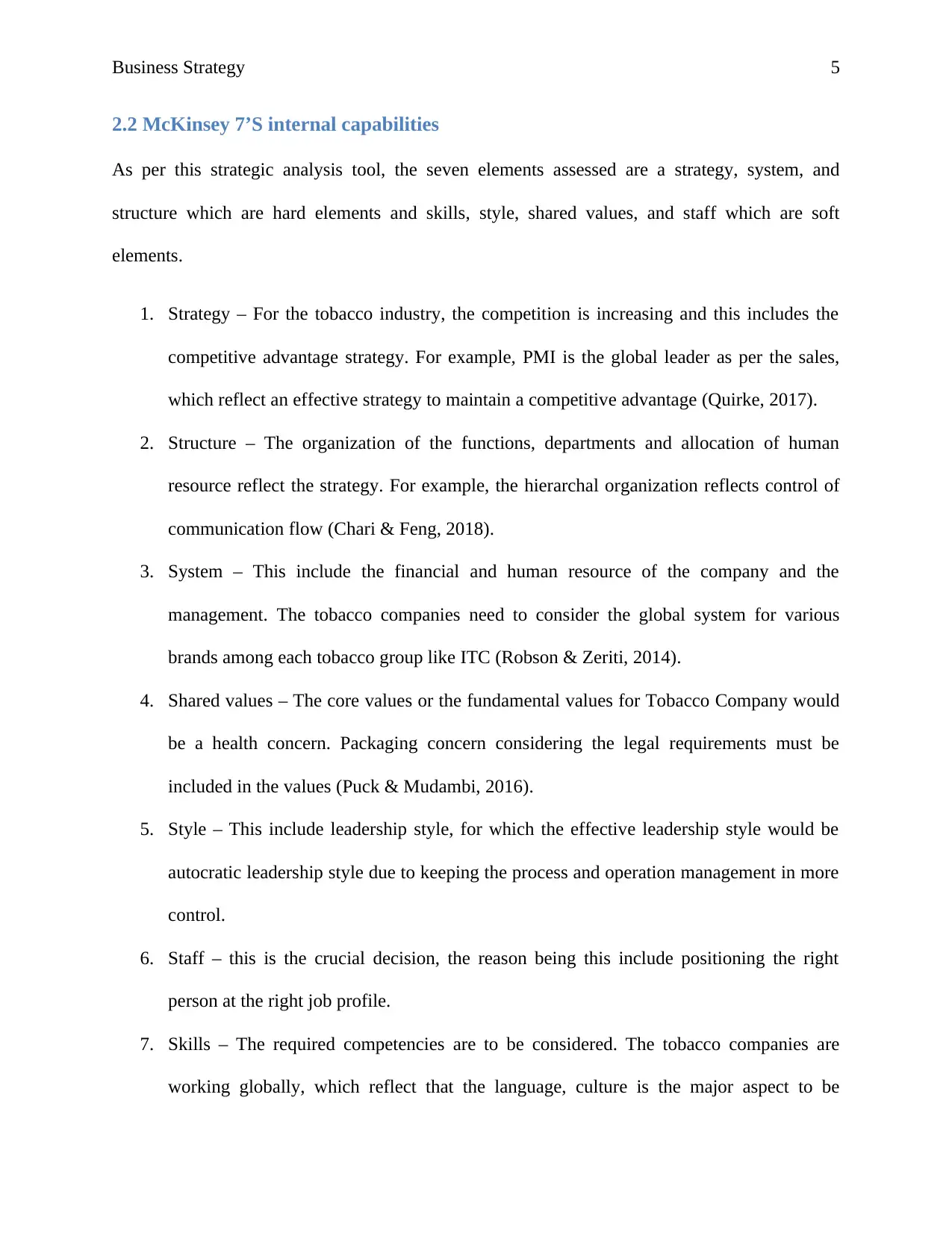
Business Strategy 5
2.2 McKinsey 7’S internal capabilities
As per this strategic analysis tool, the seven elements assessed are a strategy, system, and
structure which are hard elements and skills, style, shared values, and staff which are soft
elements.
1. Strategy – For the tobacco industry, the competition is increasing and this includes the
competitive advantage strategy. For example, PMI is the global leader as per the sales,
which reflect an effective strategy to maintain a competitive advantage (Quirke, 2017).
2. Structure – The organization of the functions, departments and allocation of human
resource reflect the strategy. For example, the hierarchal organization reflects control of
communication flow (Chari & Feng, 2018).
3. System – This include the financial and human resource of the company and the
management. The tobacco companies need to consider the global system for various
brands among each tobacco group like ITC (Robson & Zeriti, 2014).
4. Shared values – The core values or the fundamental values for Tobacco Company would
be a health concern. Packaging concern considering the legal requirements must be
included in the values (Puck & Mudambi, 2016).
5. Style – This include leadership style, for which the effective leadership style would be
autocratic leadership style due to keeping the process and operation management in more
control.
6. Staff – this is the crucial decision, the reason being this include positioning the right
person at the right job profile.
7. Skills – The required competencies are to be considered. The tobacco companies are
working globally, which reflect that the language, culture is the major aspect to be
2.2 McKinsey 7’S internal capabilities
As per this strategic analysis tool, the seven elements assessed are a strategy, system, and
structure which are hard elements and skills, style, shared values, and staff which are soft
elements.
1. Strategy – For the tobacco industry, the competition is increasing and this includes the
competitive advantage strategy. For example, PMI is the global leader as per the sales,
which reflect an effective strategy to maintain a competitive advantage (Quirke, 2017).
2. Structure – The organization of the functions, departments and allocation of human
resource reflect the strategy. For example, the hierarchal organization reflects control of
communication flow (Chari & Feng, 2018).
3. System – This include the financial and human resource of the company and the
management. The tobacco companies need to consider the global system for various
brands among each tobacco group like ITC (Robson & Zeriti, 2014).
4. Shared values – The core values or the fundamental values for Tobacco Company would
be a health concern. Packaging concern considering the legal requirements must be
included in the values (Puck & Mudambi, 2016).
5. Style – This include leadership style, for which the effective leadership style would be
autocratic leadership style due to keeping the process and operation management in more
control.
6. Staff – this is the crucial decision, the reason being this include positioning the right
person at the right job profile.
7. Skills – The required competencies are to be considered. The tobacco companies are
working globally, which reflect that the language, culture is the major aspect to be
⊘ This is a preview!⊘
Do you want full access?
Subscribe today to unlock all pages.

Trusted by 1+ million students worldwide
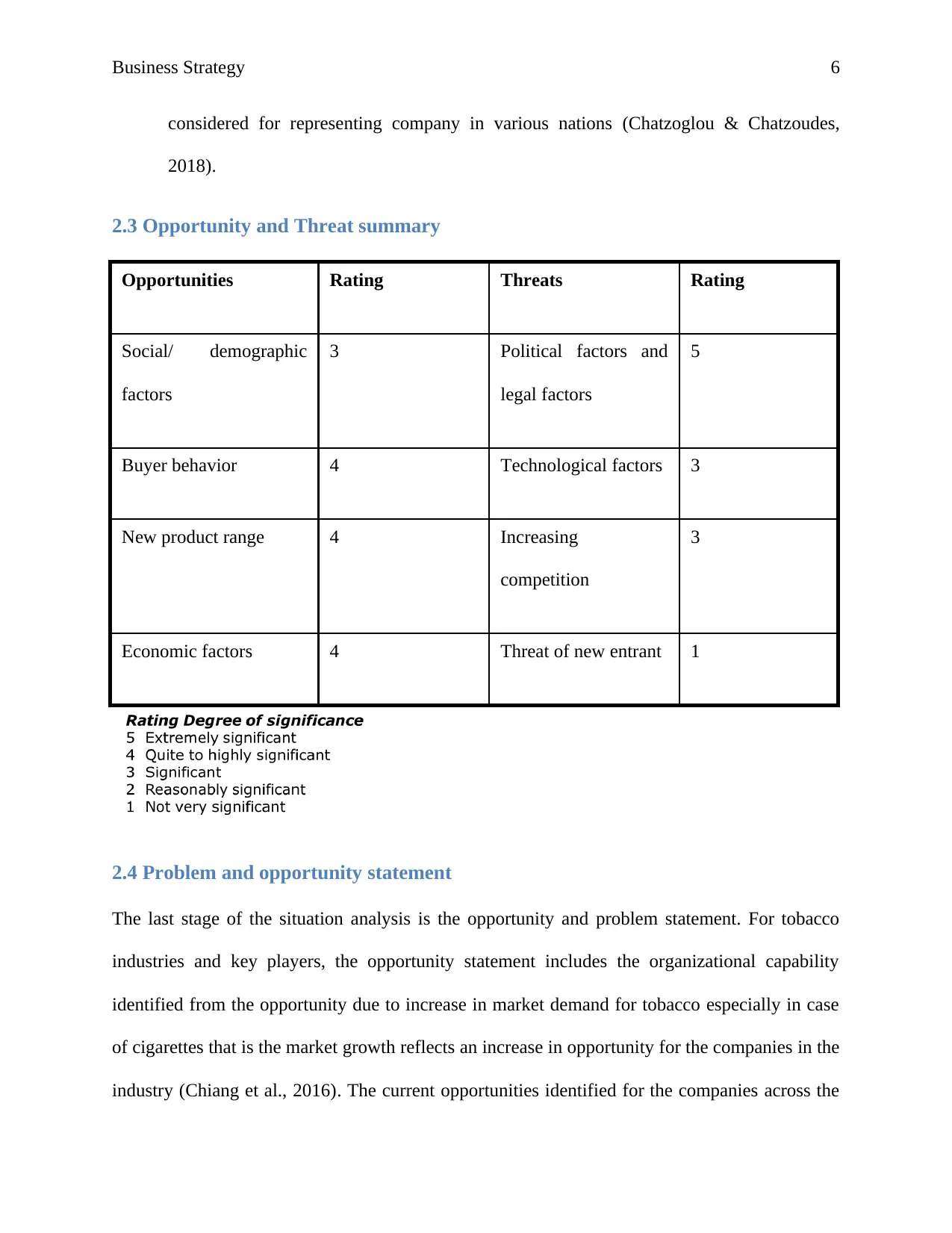
Business Strategy 6
considered for representing company in various nations (Chatzoglou & Chatzoudes,
2018).
2.3 Opportunity and Threat summary
Opportunities Rating Threats Rating
Social/ demographic
factors
3 Political factors and
legal factors
5
Buyer behavior 4 Technological factors 3
New product range 4 Increasing
competition
3
Economic factors 4 Threat of new entrant 1
2.4 Problem and opportunity statement
The last stage of the situation analysis is the opportunity and problem statement. For tobacco
industries and key players, the opportunity statement includes the organizational capability
identified from the opportunity due to increase in market demand for tobacco especially in case
of cigarettes that is the market growth reflects an increase in opportunity for the companies in the
industry (Chiang et al., 2016). The current opportunities identified for the companies across the
considered for representing company in various nations (Chatzoglou & Chatzoudes,
2018).
2.3 Opportunity and Threat summary
Opportunities Rating Threats Rating
Social/ demographic
factors
3 Political factors and
legal factors
5
Buyer behavior 4 Technological factors 3
New product range 4 Increasing
competition
3
Economic factors 4 Threat of new entrant 1
2.4 Problem and opportunity statement
The last stage of the situation analysis is the opportunity and problem statement. For tobacco
industries and key players, the opportunity statement includes the organizational capability
identified from the opportunity due to increase in market demand for tobacco especially in case
of cigarettes that is the market growth reflects an increase in opportunity for the companies in the
industry (Chiang et al., 2016). The current opportunities identified for the companies across the
Paraphrase This Document
Need a fresh take? Get an instant paraphrase of this document with our AI Paraphraser
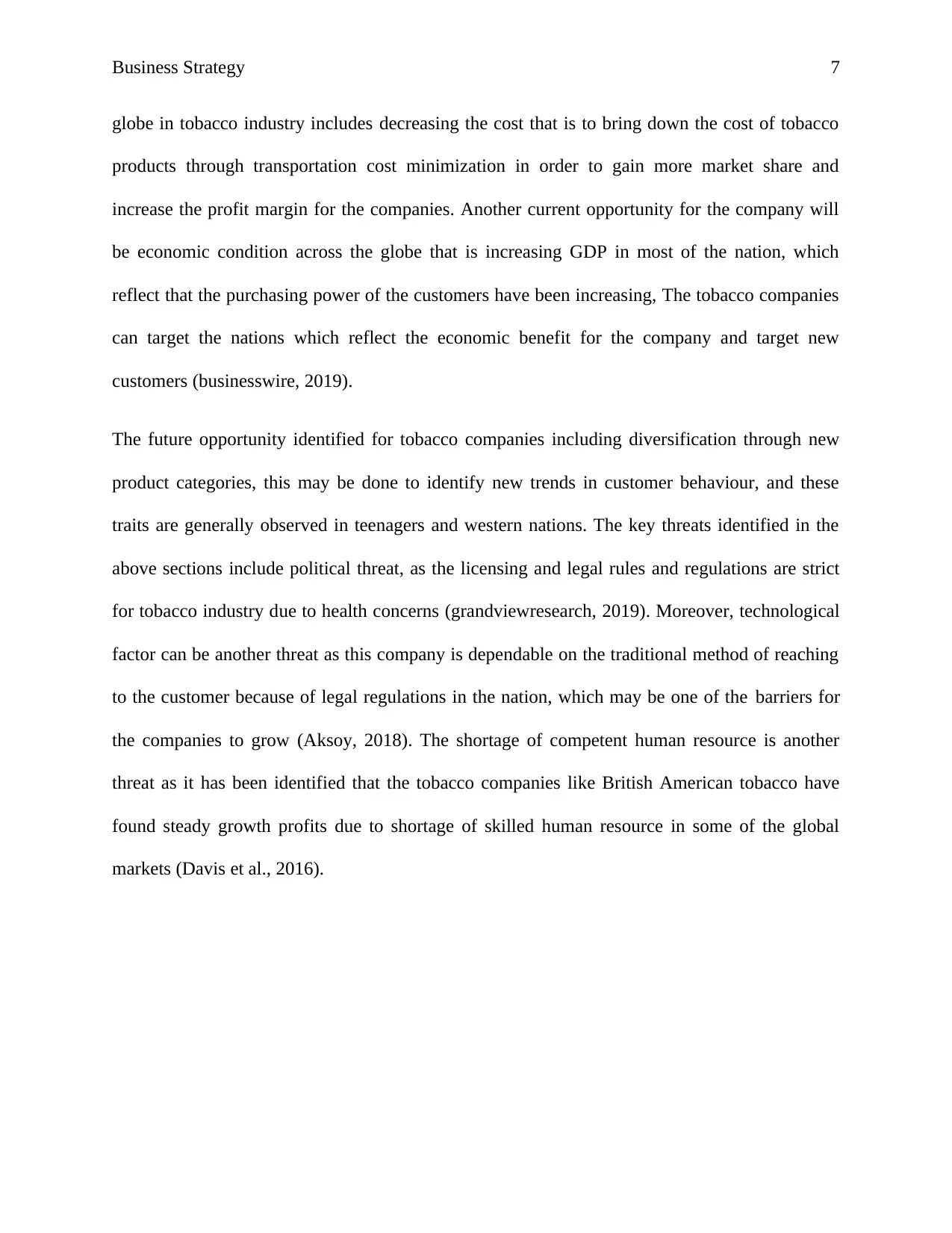
Business Strategy 7
globe in tobacco industry includes decreasing the cost that is to bring down the cost of tobacco
products through transportation cost minimization in order to gain more market share and
increase the profit margin for the companies. Another current opportunity for the company will
be economic condition across the globe that is increasing GDP in most of the nation, which
reflect that the purchasing power of the customers have been increasing, The tobacco companies
can target the nations which reflect the economic benefit for the company and target new
customers (businesswire, 2019).
The future opportunity identified for tobacco companies including diversification through new
product categories, this may be done to identify new trends in customer behaviour, and these
traits are generally observed in teenagers and western nations. The key threats identified in the
above sections include political threat, as the licensing and legal rules and regulations are strict
for tobacco industry due to health concerns (grandviewresearch, 2019). Moreover, technological
factor can be another threat as this company is dependable on the traditional method of reaching
to the customer because of legal regulations in the nation, which may be one of the barriers for
the companies to grow (Aksoy, 2018). The shortage of competent human resource is another
threat as it has been identified that the tobacco companies like British American tobacco have
found steady growth profits due to shortage of skilled human resource in some of the global
markets (Davis et al., 2016).
globe in tobacco industry includes decreasing the cost that is to bring down the cost of tobacco
products through transportation cost minimization in order to gain more market share and
increase the profit margin for the companies. Another current opportunity for the company will
be economic condition across the globe that is increasing GDP in most of the nation, which
reflect that the purchasing power of the customers have been increasing, The tobacco companies
can target the nations which reflect the economic benefit for the company and target new
customers (businesswire, 2019).
The future opportunity identified for tobacco companies including diversification through new
product categories, this may be done to identify new trends in customer behaviour, and these
traits are generally observed in teenagers and western nations. The key threats identified in the
above sections include political threat, as the licensing and legal rules and regulations are strict
for tobacco industry due to health concerns (grandviewresearch, 2019). Moreover, technological
factor can be another threat as this company is dependable on the traditional method of reaching
to the customer because of legal regulations in the nation, which may be one of the barriers for
the companies to grow (Aksoy, 2018). The shortage of competent human resource is another
threat as it has been identified that the tobacco companies like British American tobacco have
found steady growth profits due to shortage of skilled human resource in some of the global
markets (Davis et al., 2016).
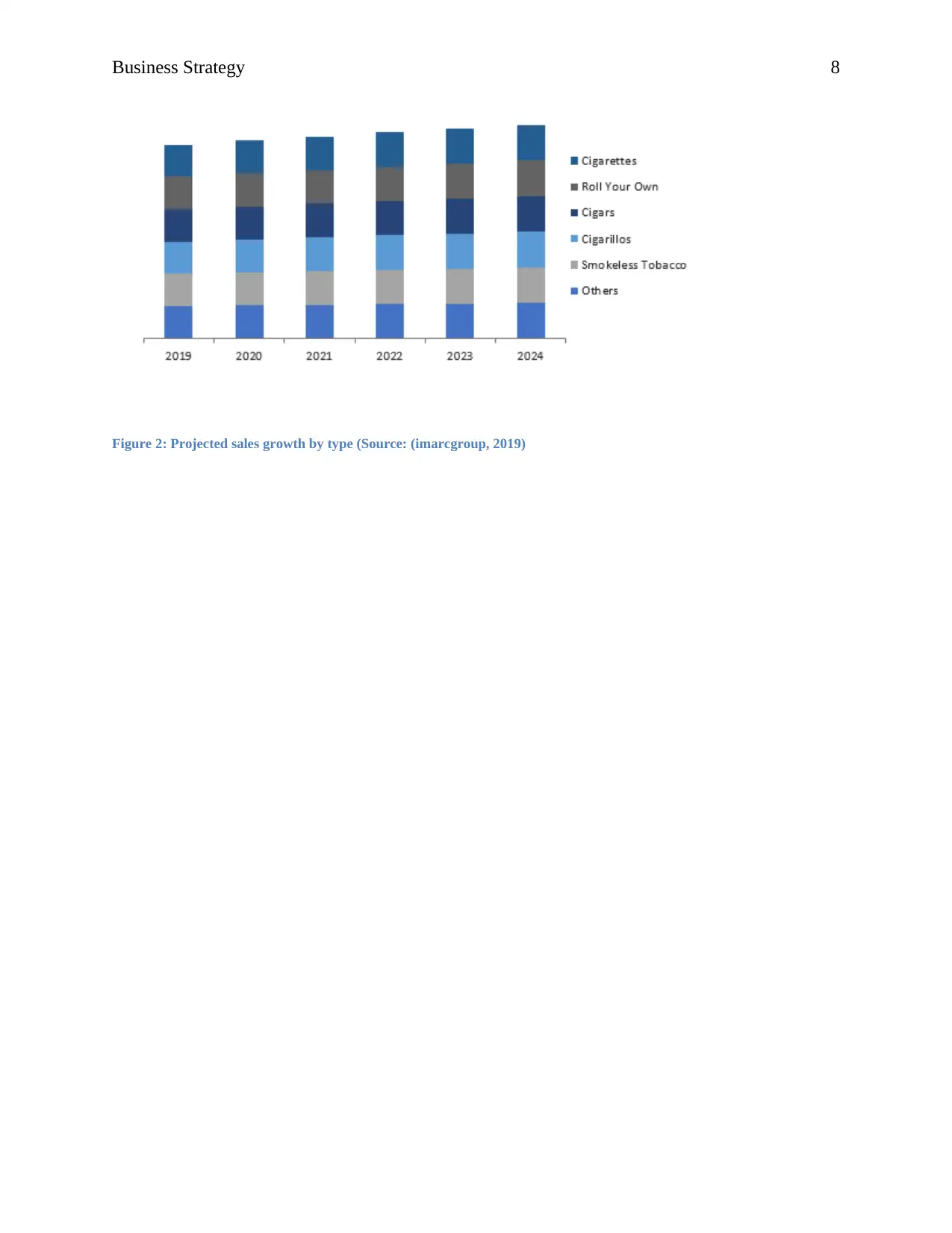
Business Strategy 8
Figure 2: Projected sales growth by type (Source: (imarcgroup, 2019)
Figure 2: Projected sales growth by type (Source: (imarcgroup, 2019)
⊘ This is a preview!⊘
Do you want full access?
Subscribe today to unlock all pages.

Trusted by 1+ million students worldwide
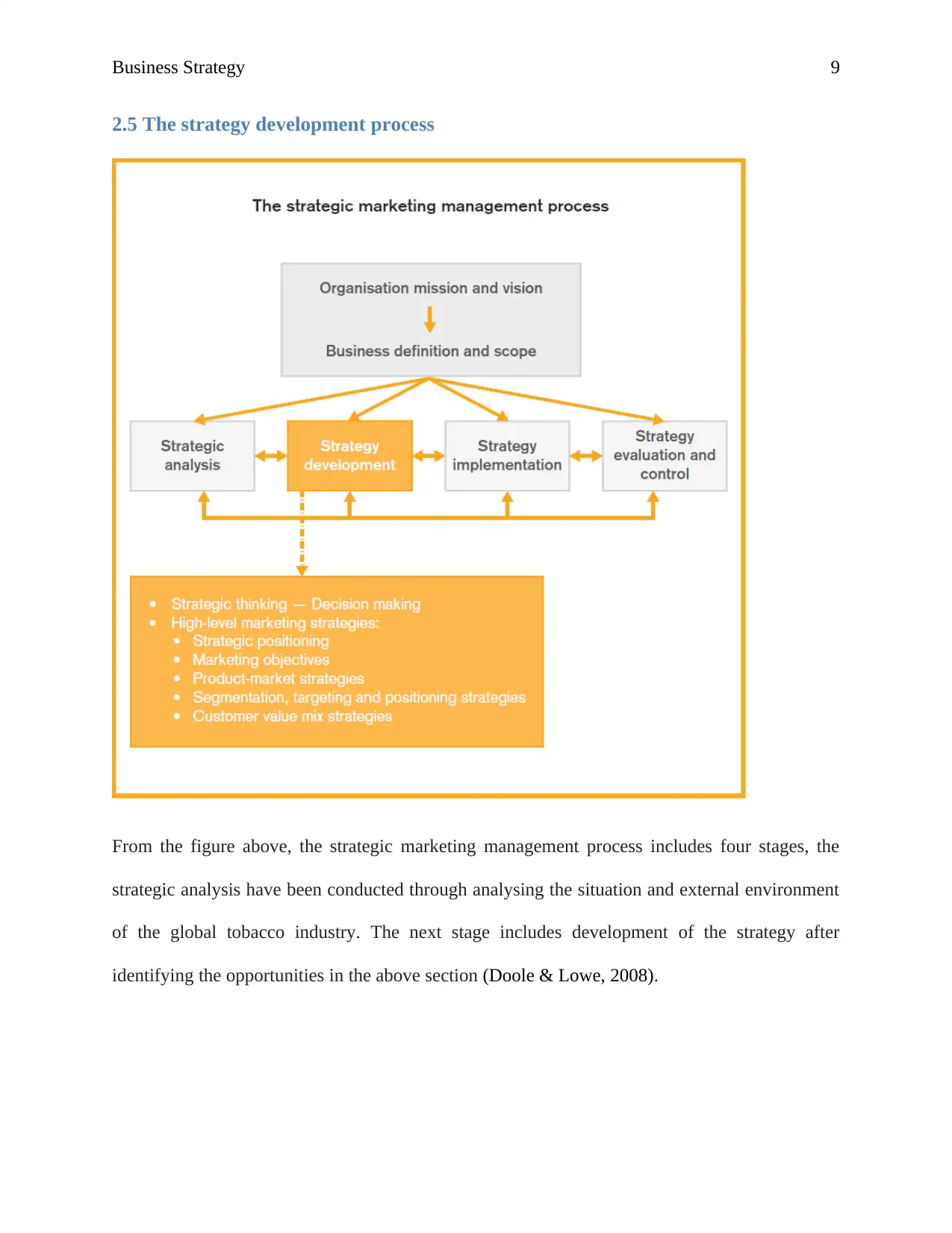
Business Strategy 9
2.5 The strategy development process
From the figure above, the strategic marketing management process includes four stages, the
strategic analysis have been conducted through analysing the situation and external environment
of the global tobacco industry. The next stage includes development of the strategy after
identifying the opportunities in the above section (Doole & Lowe, 2008).
2.5 The strategy development process
From the figure above, the strategic marketing management process includes four stages, the
strategic analysis have been conducted through analysing the situation and external environment
of the global tobacco industry. The next stage includes development of the strategy after
identifying the opportunities in the above section (Doole & Lowe, 2008).
Paraphrase This Document
Need a fresh take? Get an instant paraphrase of this document with our AI Paraphraser
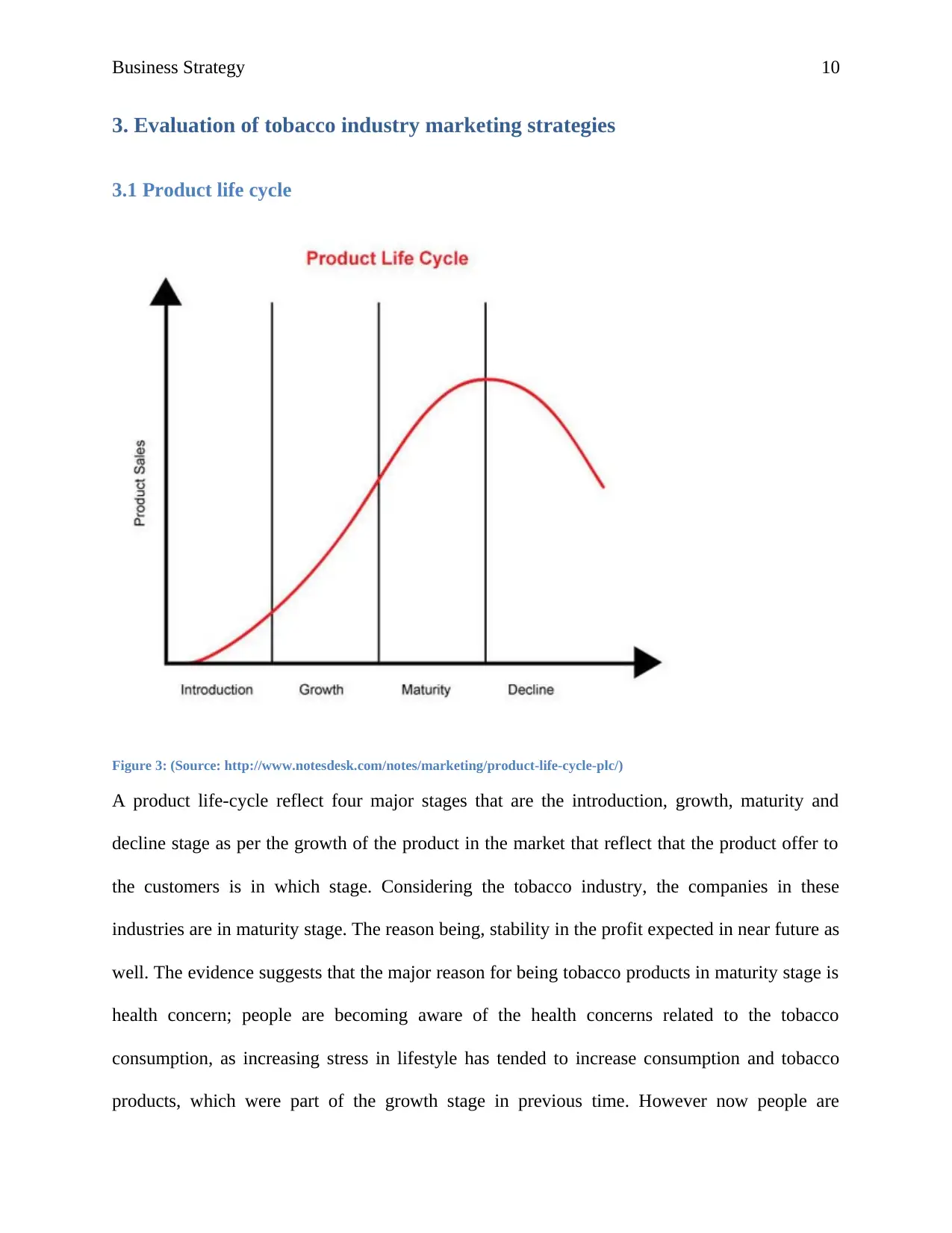
Business Strategy 10
3. Evaluation of tobacco industry marketing strategies
3.1 Product life cycle
Figure 3: (Source: http://www.notesdesk.com/notes/marketing/product-life-cycle-plc/)
A product life-cycle reflect four major stages that are the introduction, growth, maturity and
decline stage as per the growth of the product in the market that reflect that the product offer to
the customers is in which stage. Considering the tobacco industry, the companies in these
industries are in maturity stage. The reason being, stability in the profit expected in near future as
well. The evidence suggests that the major reason for being tobacco products in maturity stage is
health concern; people are becoming aware of the health concerns related to the tobacco
consumption, as increasing stress in lifestyle has tended to increase consumption and tobacco
products, which were part of the growth stage in previous time. However now people are
3. Evaluation of tobacco industry marketing strategies
3.1 Product life cycle
Figure 3: (Source: http://www.notesdesk.com/notes/marketing/product-life-cycle-plc/)
A product life-cycle reflect four major stages that are the introduction, growth, maturity and
decline stage as per the growth of the product in the market that reflect that the product offer to
the customers is in which stage. Considering the tobacco industry, the companies in these
industries are in maturity stage. The reason being, stability in the profit expected in near future as
well. The evidence suggests that the major reason for being tobacco products in maturity stage is
health concern; people are becoming aware of the health concerns related to the tobacco
consumption, as increasing stress in lifestyle has tended to increase consumption and tobacco
products, which were part of the growth stage in previous time. However now people are
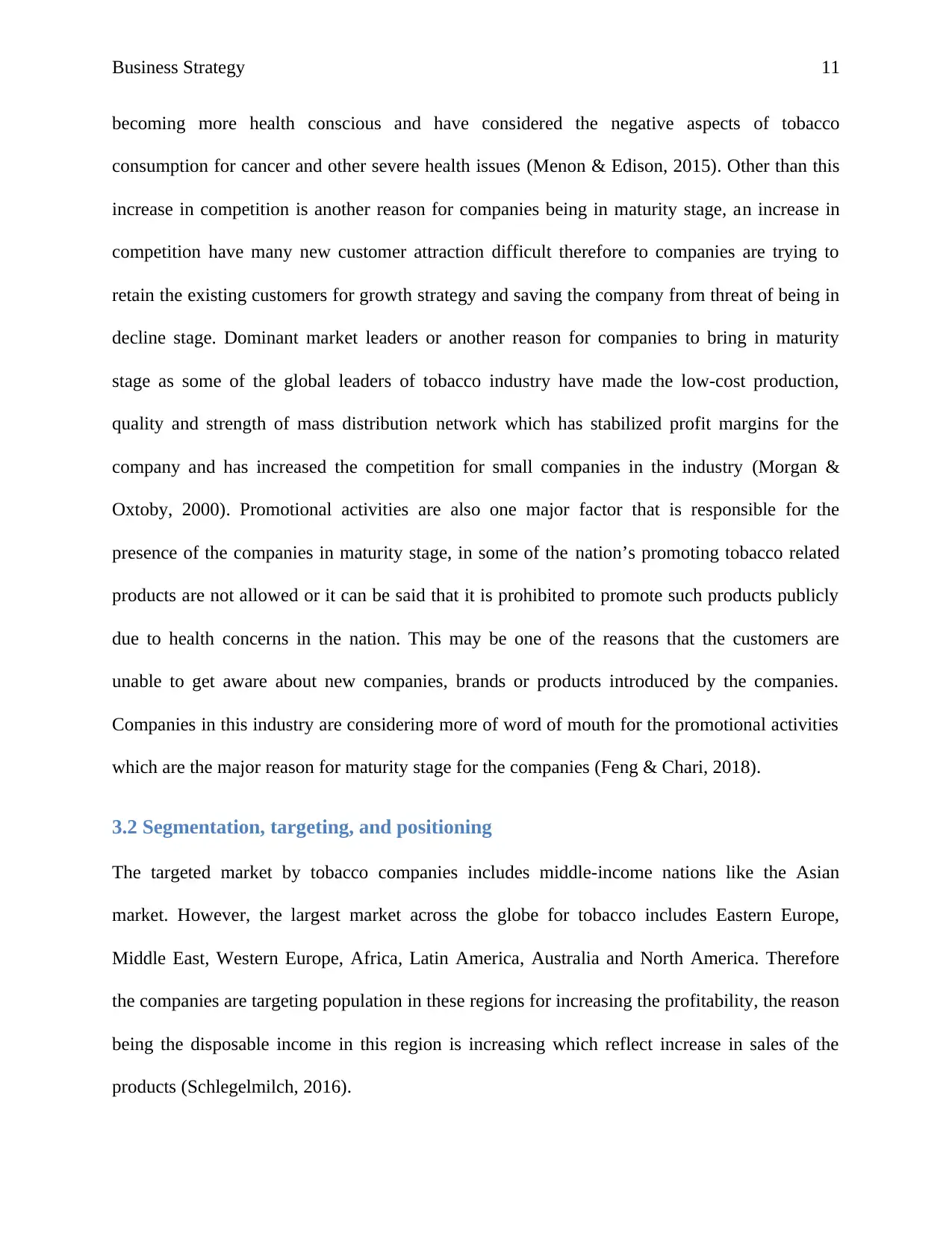
Business Strategy 11
becoming more health conscious and have considered the negative aspects of tobacco
consumption for cancer and other severe health issues (Menon & Edison, 2015). Other than this
increase in competition is another reason for companies being in maturity stage, an increase in
competition have many new customer attraction difficult therefore to companies are trying to
retain the existing customers for growth strategy and saving the company from threat of being in
decline stage. Dominant market leaders or another reason for companies to bring in maturity
stage as some of the global leaders of tobacco industry have made the low-cost production,
quality and strength of mass distribution network which has stabilized profit margins for the
company and has increased the competition for small companies in the industry (Morgan &
Oxtoby, 2000). Promotional activities are also one major factor that is responsible for the
presence of the companies in maturity stage, in some of the nation’s promoting tobacco related
products are not allowed or it can be said that it is prohibited to promote such products publicly
due to health concerns in the nation. This may be one of the reasons that the customers are
unable to get aware about new companies, brands or products introduced by the companies.
Companies in this industry are considering more of word of mouth for the promotional activities
which are the major reason for maturity stage for the companies (Feng & Chari, 2018).
3.2 Segmentation, targeting, and positioning
The targeted market by tobacco companies includes middle-income nations like the Asian
market. However, the largest market across the globe for tobacco includes Eastern Europe,
Middle East, Western Europe, Africa, Latin America, Australia and North America. Therefore
the companies are targeting population in these regions for increasing the profitability, the reason
being the disposable income in this region is increasing which reflect increase in sales of the
products (Schlegelmilch, 2016).
becoming more health conscious and have considered the negative aspects of tobacco
consumption for cancer and other severe health issues (Menon & Edison, 2015). Other than this
increase in competition is another reason for companies being in maturity stage, an increase in
competition have many new customer attraction difficult therefore to companies are trying to
retain the existing customers for growth strategy and saving the company from threat of being in
decline stage. Dominant market leaders or another reason for companies to bring in maturity
stage as some of the global leaders of tobacco industry have made the low-cost production,
quality and strength of mass distribution network which has stabilized profit margins for the
company and has increased the competition for small companies in the industry (Morgan &
Oxtoby, 2000). Promotional activities are also one major factor that is responsible for the
presence of the companies in maturity stage, in some of the nation’s promoting tobacco related
products are not allowed or it can be said that it is prohibited to promote such products publicly
due to health concerns in the nation. This may be one of the reasons that the customers are
unable to get aware about new companies, brands or products introduced by the companies.
Companies in this industry are considering more of word of mouth for the promotional activities
which are the major reason for maturity stage for the companies (Feng & Chari, 2018).
3.2 Segmentation, targeting, and positioning
The targeted market by tobacco companies includes middle-income nations like the Asian
market. However, the largest market across the globe for tobacco includes Eastern Europe,
Middle East, Western Europe, Africa, Latin America, Australia and North America. Therefore
the companies are targeting population in these regions for increasing the profitability, the reason
being the disposable income in this region is increasing which reflect increase in sales of the
products (Schlegelmilch, 2016).
⊘ This is a preview!⊘
Do you want full access?
Subscribe today to unlock all pages.

Trusted by 1+ million students worldwide
1 out of 20
Related Documents
Your All-in-One AI-Powered Toolkit for Academic Success.
+13062052269
info@desklib.com
Available 24*7 on WhatsApp / Email
![[object Object]](/_next/static/media/star-bottom.7253800d.svg)
Unlock your academic potential
Copyright © 2020–2025 A2Z Services. All Rights Reserved. Developed and managed by ZUCOL.





